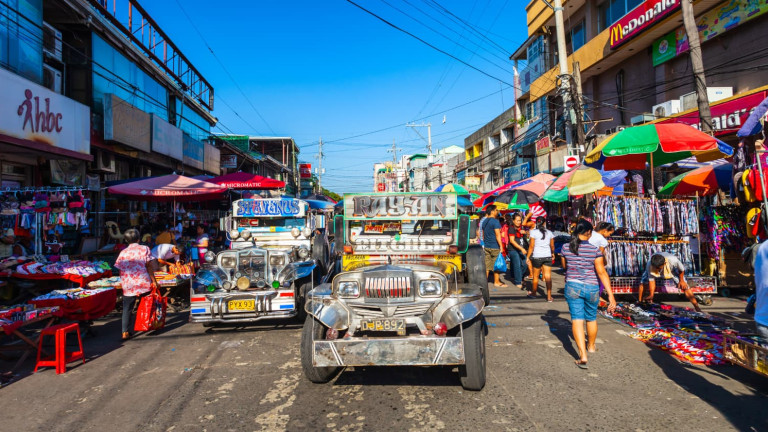Philippines: Economy in a good position to face headwinds
Highlights
- GDP growth is expected to slow down this year after two strong years.
- The global economic slowdown, weakening external demand for manufactured exports and geopolitical tensions all constitute downside risks.
- The country’s low external debt, adequate liquidity and continued prudent government policies are supportive buffers in an uncertain climate.
- President Marcos Jr’s strengthening of the security alliance with the USA is increasing tensions with China in the South China Sea.
- The outlook is stable for the country’s risk ratings.
Pros
Cons
Head of State and of Government
Population
GDP per capita
Income group
Main export products
Economic momentum in the Philippines is expected to slow down for the rest of the year amid domestic and external headwinds, but should remain strong following the good performances seen between mid-2021 and the first quarter of this year. After its worst recession in history (-9.5%) in 2020 caused by the Covid-19 pandemic, the country’s economy gradually recovered in 2021 (+5.7%) and accelerated last year (+7.6%), driven by a revival of private demand and stronger investments amid a waning pandemic and the lifting of mobility restrictions.
Like its South-East Asian neighbours, this year’s outlook is clouded by the global economic slowdown, weakening domestic and external demand (affecting manufactured exports, particularly electronics), and heightened geopolitical tensions. Ongoing infrastructure projects related to the “Build Better More” (2022-2028) government programme and improving Chinese demand – notably from tourism – will help mitigate the overall negative trend in regional and global trade, but the support from the latter has yet to materialise. Global uncertainty remains high and could bring real GDP growth – at 6% this year – to lower (although still elevated) levels, and so closer to its potential. Despite sticky food and fuel price inflation, an economic slowdown could push inflation down further after it rose to 8.1% in 2022 (the highest rate among the five largest economies in South-East Asia), but which has been easing since February (+6.6% in April) and could be closer to the government’s upper inflation target (4%) by the end of the year. This could mean the end of additional monetary tightening measures – as the graph below shows, the Central Bank’s policy rate, shown in orange, remained stable at 6.25% in May at the same time as inflation is going down – especially when the trend of the peso is also taken into account. The currency has remained stable so far this year vis-à-vis the US dollar, and could be further underpinned by multiple factors. On the one hand, the end of the US interest hike cycle could ease future depreciating pressures on the peso. On the other hand, following a sharp widening due to the impact of the war in Ukraine on import costs, the narrowing of the current account deficit (from 4.4% of GDP in 2022 to 2.5% expected this year), on the back of falling commodity price imports and resilient workers’ remittances above 20% of current account receipts, will also support the peso.

In a challenging environment, the Philippines’ sound macroeconomic fundamentals and banking system are good buffers to deal with external shocks. Liquidity is strong, with robust foreign exchange reserves (over 6 months of import cover), and a rather weak short-term external debt. Moreover, external debt ratios and debt service are adequate amid tightened global monetary conditions and help in keeping the country’s financial risk at low levels. The situation is less rosy when it comes to public finances, as large fiscal deficits and government support during the pandemic have increased public debt by 20 percentage points, from 37% of GDP in 2019 to 57.5% in 2022. Some stabilisation is forecast in the medium term however, and it is worth pointing out that under successive presidents (i.e. both Ferdinand Marcos Jr. and the man he succeeded last July, Rodrigo Duterte), government policy continuity, cautious management and investor-friendly stances have remained the norm, and contribute to a high degree of business and market confidence in the country. It is still to be seen, however, if the current administration will reverse setbacks made in relation to the rule of law, civic rights and corruption control during Duterte’s leadership. Last February, the Philippines was one of the last members to ratify the RCEP (Regional Comprehensive Economic Partnership), a free trade agreement among 15 members countries from Asia and the Pacific, including China. This came into force on 2 June, therefore, it should boost the Philippines’ regional trade and its investment attractiveness.
One major change between the two presidents, however, concerns defence policy. While Duterte had built closer ties with China and attempted to distance the country from the USA, Marcos Jr. has taken a more balanced approach. Since coming to power, he has been actively tightening security links with its US ally at the same time as the US-Chinese rivalry worsens, leading to increased tensions around disputed islands and between Philippine and Chinese vessels in the South China Sea. In the meantime, Manilla continues to cultivate good trade relations with Beijing. In due course, however, these may be damaged by the rising maritime tensions, especially given that the USA and the Philippines are planning joint maritime patrols for later this year, much to China’s displeasure. A further risk comes from climate change. In South-East Asia, the Philippines are among the most exposed to extreme natural disasters, particularly the more destructive typhoons and hotter temperatures. The rising frequency and intensity of these conditions is likely to affect future economic performances.
Looking ahead, Credendo’s risk ratings are between the good and moderate levels and currently maintain a stable outlook.
Analyst: Raphaël Cecchi – r.cecchi@credendo.com
